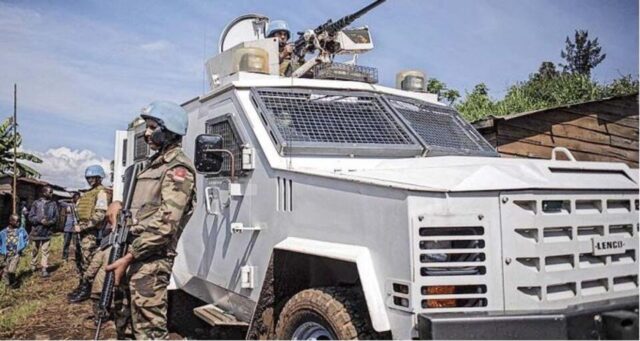OPINION: It feels like there is no end to the deadly fighting that has wreaked havoc in the eastern region of the Democratic Republic of Congo for decades, resulting in the deaths of over one million people and the displacement of six million people across the region, writes Dr Sizo Nkala.
By Dr Sizo Nkala
It feels like there is no end to the deadly fighting that has wreaked havoc in the eastern region of the Democratic Republic of Congo (DRC) for decades, resulting in the deaths of over one million people and the displacement of six million people across the region.
In recent weeks, fighting has intensified between the Tutsi-led March 23 Movement (M23), one of the most formidable rebel groups operating in the eastern provinces of DRC, and the government armed forces.
The M23 is made up of the Congolese Tutsi with links to Rwanda who are fighting for the interests of their ethnic group. Heavy gunfights have been witnessed in the DRC town of Sake, pitting government forces helped by United Nations (UN )peacekeepers and the M23 rebels who want to take control of the town.
The Sake town lies about 25km north-west of Goma, the capital city of the troubled North Kivu province. It is believed that capturing the highly strategic town would be a stepping stone to taking control of Goma which the rebel group once captured in 2012. As such, the DRC government and the UN peacekeepers want to prevent that at all costs.
According to the United Nations High Commissioner for Refugees (UNHCR) about 135, 000 people have fled their homes in Sake and headed for Goma. About 35 people have lost their lives and scores of others injured since the beginning of the year when hostilities intensified. The government forces and the rebels have blamed each other for the fatalities.
The DRC government has accused its eastern neighbour, Rwanda of supporting the M23 rebels. On the campaign trail for the December 2023 presidential elections, the DRC President Felix Tshisekedi was quoted as saying, “I’ve had enough of invasions and M23 rebels backed by Kigali. If you re-elect me and Rwanda persists … I will request parliament and Congress to authorise a declaration of war. We will march on Kigali. Tell Kagame those days of playing games with Congolese leaders are over.”
These allegations have been backed by the United Nations Group of Experts report released in 2023, which urged Rwanda to suspend its support for the M23 and also withdraw the Rwanda Defence Force (RDF) troops from the DRC territory.
The United States and France have also confirmed these allegations. However, Kigali has dismissed the allegations as false. Rwanda has gone further to accuse the DRC government of backing the Hutu-led Democratic Forces for the Liberation of Rwanda (DFLR), which it says is made up of Hutu extremists and those who participated in the 1994 genocide and intend to overthrow Paul Kagame’s government.
The stand-off between the two countries has hampered progress in the East African Community-led Nairobi and Luanda processes, which seek to find a political solution to the armed groups in eastern DRC and restore diplomatic relations between Rwanda and the DRC.
Seemingly following up on his election campaign promises to end instability in the east, Tshisekedi invited the Southern African Development Community (SADC) to intervene and help quell the situation.
Consequently, the SADC Mission in the DRC (SAMIDRC) was deployed in December 2023. Recently, South Africa contributed 2,900 troops to the SADC Mission. The SAMIDRC will replace the East African Community Regional Force (EACRF) which was asked to pull out by the DRC government after failing to eliminate the rebel groups.
Despite having some early victories, the EACRF could not contain the M23 rebels who continued to capture more territory and even took over some areas where the regional force was stationed.
Tshisekedi accused the EACRF of working with the rebels and being reluctant to use effective force against the main rebel group, the M23. The regional force was also compromised by the presence of some countries like Uganda and Burundi who are accused of taking advantage of the chaos in the country to loot its natural resources. As such, it remains to be seen whether the SAMIDRC will succeed where the EACRF and the United Nations Organisation Stabilisation Mission in the Democratic Republic of the Congo (Monusco) which has been deployed for the last 25 years, have failed.
Monusco will also be leaving DRC at the end of 2024 after the UN Security Council (UNSC) agreed to end its mandate in December 2024. Its withdrawal came amid sustained calls by the DRC government for it to pull out and frequent protests by the Congolese people in the eastern region who were disillusioned by its failure to deal with the insurgents.
However, judging by how the SADC forces have fared in Mozambique’s Cabo Delgado province which is also affected by an armed insurgency where the SADC Mission in Mozambique has been deployed since 2022, it doesn’t look like SAMIDRC will be the quick solution the DRC government and its people are looking for.
It has become clear, over the years that military intervention will not end the violence in the east of DRC. The DRC government should build up its security forces which have been incapacitated by corrupt politicians, and rendered hapless in the face of heavily armed rebels. Moreover, a political solution should complement military interventions. As such, it is important for all parties involved to keep the Luanda and the Nairobi processes alive.
* Dr Sizo Nkala is A Research Fellow at the University of Johannesburg’s Centre for Africa-China Studies.
** The views expressed do not necessarily reflect the views of the DFA.








